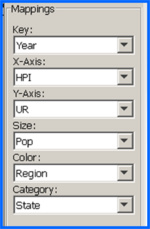SOCR MotionCharts HousingPriceIndex
From Socr
(New page: == SOCR Charts Activities - DOT CHARTS == == Summary== This activity describes the need, general methods and SOCR utilities for the dot cart. ==G...) |
m (format) |
||
| (21 intermediate revisions not shown) | |||
| Line 1: | Line 1: | ||
| - | == [[ | + | == [[SOCR_MotionCharts| SOCR MotionCharts Activities]] - Housing Price Index Activity == |
== Summary== | == Summary== | ||
| - | This activity | + | This activity demonstrates the usage and functionality of [http://socr.ucla.edu/SOCR_MotionCharts/ SOCR MotionCharts] using the [[SOCR_Data_Dinov_010309_HousingPriceIndex | SOCR Housing Price Index dataset]]. |
==Goals== | ==Goals== | ||
The aims of this activity is to: | The aims of this activity is to: | ||
| - | * | + | * demonstrate SOCR MotionCharts data import, manipulations and graphical interpretation |
| - | * | + | * interactively explore the graphical visualization of real-life multidimensional datasets |
| - | * | + | * complex data navigation from different directions (using data mappings). |
==Background == | ==Background == | ||
| - | + | The amount, complexity and provenance of data has dramatically increased in the last few years. Visualization of observed and simulated data is a critical component of any social, environmental, biomedical or scientific quest. Dynamic, exploratory and interactive visualization of multivariate data, without preprocessing by dimensionality reduction, remains an insurmountable challenge. [http://socr.ucla.edu/SOCR_MotionCharts/ SOCR MotionCharts] provide a new paradigm for discovery-based exploratory analysis of multivariate data. This interactive data visualization tool enables the visualization of high-dimensional longitudinal data. SOCR Motion Charts allows mapping of ordinal, nominal and quantitative variables onto time, axes, size, colors, glyphs and appearance characteristics, which facilitates the interactive display of multidimensional data. SOCR Motion Charts can be used as instructional tool for rendering and interrogating high-dimensional data in the classroom, as well as a research tool for exploratory data analysis. | |
| - | + | ||
| - | + | ||
| - | + | ||
== Description == | == Description == | ||
| + | In addition to this activity, open 2 more browser tabs - one pointing to the [http://socr.ucla.edu/SOCR_MotionCharts/ SOCR MotionCharts applet] and the other displaying the [[SOCR_Data_Dinov_010309_HousingPriceIndex | SOCR Housing Price Index dataset]]. The image below shows the arrangement of these 3 browser tabs. | ||
| + | <center>[[Image:SOCR_Activities_MotionCharts_HPI_070109_Fig1.png|250px]] [[Image:SOCR_Activities_MotionCharts_HPI_070109_Fig2.png|250px]] [[Image:SOCR_Activities_MotionCharts_HPI_070109_Fig3.png|250px]] | ||
| + | </center> | ||
| - | + | ==Activity videos== | |
| + | The video below demonstrate the mechanics of using the SOCR Motion Charts to analyze longitudinal multivariate data in the context of these Housing Price Index Data: | ||
| + | * A low-resolution video stream of this Activity is available on [http://www.youtube.com/watch?v=2txCubXTt_0 YouTube], and [http://www.socr.ucla.edu/docs/videos/SOCR_HousingPriceActivity_July2010.mp4 here is a high resolution analogue (40MB)]. | ||
| - | + | ==Activity== | |
| + | The [[SOCR_Data_Dinov_010309_HousingPriceIndex | house price index]] data was provided by the Office of Federal Housing Enterprise Oversight. The data represents the average housing price for all states between the years 2000 and 2006. The data also includes the average unemployment rate, population (in thousands), the percent subprime loans, and the region by state. | ||
| - | + | * Using the mouse, copy the [[SOCR_Data_Dinov_010309_HousingPriceIndex |data from the SOCR data web page]], click on the first cell (top-left) in the DATA tab of the [http://socr.ucla.edu/SOCR_MotionCharts/ SOCR Motion Charts applet], and paste the data in the spreadsheet. | |
| + | <center>[[Image:SOCR_Activities_MotionCharts_HPI_070109_Fig4.png|400px]]</center> | ||
| - | + | * Next, you need to map the column-variables to different properties it the SOCR MotionChart. For example, you can use the following mapping: | |
| + | <center> | ||
| + | [[Image:SOCR_Activities_MotionCharts_HPI_070109_Fig5.png|150px|thumbnail|right| SOCR MotionChart Data Mapping]] | ||
| + | {| class="wikitable" | ||
| + | |- | ||
| + | ! || colspan=6 | Variables | ||
| + | |- | ||
| + | ! [http://socr.ucla.edu/SOCR_MotionCharts/ SOCR MotionChart Property] || Key || X-Axis || Y-Axis || Size || Color || Category | ||
| + | |- | ||
| + | ! [[SOCR_Data_Dinov_010309_HousingPriceIndex | Data Column Name]] || Year || HPI || UR || Pop || Region || State | ||
| + | |} | ||
| + | </center> | ||
| - | + | The figures below represent snapshots of the generated dynamic SOCR motion chart. In the real applet, you can ''play'' (animate) or ''scroll'' (1-year steps) through the years (2000, ..., 2006). Notice the position change between different snapshots of the time slider on the bottom of these figures. Also, mouse-over a blob triggers a dynamic graphical pop-up providing additional information about the data for the specified blob in the chart. | |
| - | + | <center>[[Image:SOCR_Activities_MotionCharts_HPI_070109_Fig6_9_Animation.gif|250px]] | |
| - | + | [[Image:SOCR_Activities_MotionCharts_HPI_070109_Fig6.png|150px]] | |
| - | + | [[Image:SOCR_Activities_MotionCharts_HPI_070109_Fig7.png|150px]] | |
| + | [[Image:SOCR_Activities_MotionCharts_HPI_070109_Fig8.png|150px]] | ||
| + | [[Image:SOCR_Activities_MotionCharts_HPI_070109_Fig9.png|150px]] | ||
| + | </center> | ||
| - | + | You can also change what variables (data columns) are mapped to the following SOCR MotionCharts properties: | |
| + | * ''Key, X-Axis, Y-Axis, Size, Color'' and ''Category''. Changing the variable-property mapping allows you to explore the data from a different perspective. | ||
| - | + | == Data type and format == | |
| - | + | SOCR Motion Charts currently accepts three types of data: numbers, dates/time, and strings. With these data types, the SOCR MotionCharts applet is able to handle the majority of data types. Internally, the applet uses the ''natural (lexicological) ordering'' of these data as defined by Java primitive data types. While many types of data can be interpreted as strings, in some cases it may not be appropriate to use string-data lexicological ordering. When designing SOCR MotionCharts, we took this into consideration and designed the applet so that it can easily be extended to provide a greater variety of interpreted types. Thus, a developer may easily extend the applet to provide another data type interpretation for specific types of data. | |
| - | + | ||
== Applications == | == Applications == | ||
| + | The SOCR MotionCharts can be used in a variety of applications to visualize dynamic relationships in multidimensional data in up to 5 dimensions, plus a 6 temporal component. The applet's design and implementation allow for extensions enabling and supporting higher dimensions plug-ins. The overall purpose of SOCR MotionCharts is to provide users with a way to visualize the relationships between multiple variables over a period of time in a simple, intuitive and animated fashion. | ||
| - | + | ==References== | |
| - | + | * Al-Aziz, J, Christou, N, Dinov, ID. (2010). [http://www.amstat.org/publications/jse/v18n3/dinov.pdf SOCR Motion Charts: An Efficient, Open-Source, Interactive and Dynamic Applet for Visualizing Longitudinal Multivariate Data], [http://www.amstat.org/publications/jse/contents_2010.htm JSE, 18(3)], 1-29. | |
| - | + | ||
| - | + | ||
| - | + | ||
{{translate|pageName=http://wiki.stat.ucla.edu/socr/index.php?title=SOCR_MotionCharts_HousingPriceIndex}} | {{translate|pageName=http://wiki.stat.ucla.edu/socr/index.php?title=SOCR_MotionCharts_HousingPriceIndex}} | ||
Current revision as of 00:18, 28 November 2010
Contents |
SOCR MotionCharts Activities - Housing Price Index Activity
Summary
This activity demonstrates the usage and functionality of SOCR MotionCharts using the SOCR Housing Price Index dataset.
Goals
The aims of this activity is to:
- demonstrate SOCR MotionCharts data import, manipulations and graphical interpretation
- interactively explore the graphical visualization of real-life multidimensional datasets
- complex data navigation from different directions (using data mappings).
Background
The amount, complexity and provenance of data has dramatically increased in the last few years. Visualization of observed and simulated data is a critical component of any social, environmental, biomedical or scientific quest. Dynamic, exploratory and interactive visualization of multivariate data, without preprocessing by dimensionality reduction, remains an insurmountable challenge. SOCR MotionCharts provide a new paradigm for discovery-based exploratory analysis of multivariate data. This interactive data visualization tool enables the visualization of high-dimensional longitudinal data. SOCR Motion Charts allows mapping of ordinal, nominal and quantitative variables onto time, axes, size, colors, glyphs and appearance characteristics, which facilitates the interactive display of multidimensional data. SOCR Motion Charts can be used as instructional tool for rendering and interrogating high-dimensional data in the classroom, as well as a research tool for exploratory data analysis.
Description
In addition to this activity, open 2 more browser tabs - one pointing to the SOCR MotionCharts applet and the other displaying the SOCR Housing Price Index dataset. The image below shows the arrangement of these 3 browser tabs.
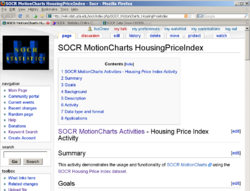
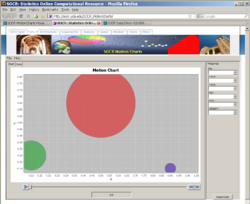
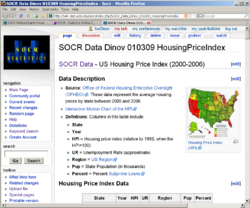
Activity videos
The video below demonstrate the mechanics of using the SOCR Motion Charts to analyze longitudinal multivariate data in the context of these Housing Price Index Data:
- A low-resolution video stream of this Activity is available on YouTube, and here is a high resolution analogue (40MB).
Activity
The house price index data was provided by the Office of Federal Housing Enterprise Oversight. The data represents the average housing price for all states between the years 2000 and 2006. The data also includes the average unemployment rate, population (in thousands), the percent subprime loans, and the region by state.
- Using the mouse, copy the data from the SOCR data web page, click on the first cell (top-left) in the DATA tab of the SOCR Motion Charts applet, and paste the data in the spreadsheet.
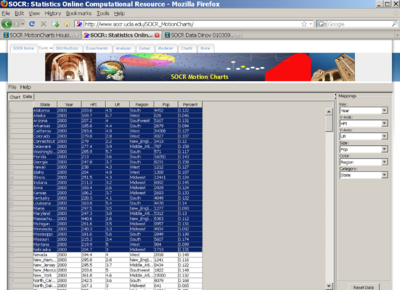
- Next, you need to map the column-variables to different properties it the SOCR MotionChart. For example, you can use the following mapping:
| Variables | ||||||
|---|---|---|---|---|---|---|
| SOCR MotionChart Property | Key | X-Axis | Y-Axis | Size | Color | Category |
| Data Column Name | Year | HPI | UR | Pop | Region | State |
The figures below represent snapshots of the generated dynamic SOCR motion chart. In the real applet, you can play (animate) or scroll (1-year steps) through the years (2000, ..., 2006). Notice the position change between different snapshots of the time slider on the bottom of these figures. Also, mouse-over a blob triggers a dynamic graphical pop-up providing additional information about the data for the specified blob in the chart.
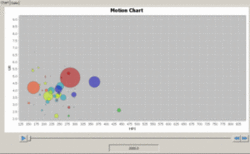
You can also change what variables (data columns) are mapped to the following SOCR MotionCharts properties:
- Key, X-Axis, Y-Axis, Size, Color and Category. Changing the variable-property mapping allows you to explore the data from a different perspective.
Data type and format
SOCR Motion Charts currently accepts three types of data: numbers, dates/time, and strings. With these data types, the SOCR MotionCharts applet is able to handle the majority of data types. Internally, the applet uses the natural (lexicological) ordering of these data as defined by Java primitive data types. While many types of data can be interpreted as strings, in some cases it may not be appropriate to use string-data lexicological ordering. When designing SOCR MotionCharts, we took this into consideration and designed the applet so that it can easily be extended to provide a greater variety of interpreted types. Thus, a developer may easily extend the applet to provide another data type interpretation for specific types of data.
Applications
The SOCR MotionCharts can be used in a variety of applications to visualize dynamic relationships in multidimensional data in up to 5 dimensions, plus a 6 temporal component. The applet's design and implementation allow for extensions enabling and supporting higher dimensions plug-ins. The overall purpose of SOCR MotionCharts is to provide users with a way to visualize the relationships between multiple variables over a period of time in a simple, intuitive and animated fashion.
References
- Al-Aziz, J, Christou, N, Dinov, ID. (2010). SOCR Motion Charts: An Efficient, Open-Source, Interactive and Dynamic Applet for Visualizing Longitudinal Multivariate Data, JSE, 18(3), 1-29.
Translate this page:
